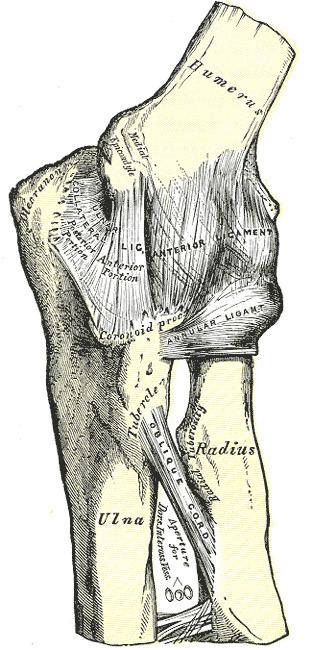Dorlands/Elsevier a_64/12161255 FMA 38855 | TA A03.5.09.003 | |
 | ||
Latin Articulatio humeroradialis | ||
The humeroradial joint is the joint between the head of the radius and the capitulum of the humerus, is a limited ball-and-socket joint, hinge type of synovial joint.
The bony surfaces would of themselves constitute an enarthrosis and allow movement in all directions, were it not for the annular ligament, by which the head of the radius is bound to the radial notch of the ulna, and which prevents any separation of the two bones laterally.
The annular ligament secures the head of the radius from dislocation, which would otherwise tend to occur, from the shallowness of the cup-like surface on the head of the radius. Without this ligament, the tendon of the biceps brachii would be liable to pull the head of the radius out of the joint.
The head of the radius is not in complete contact with the capitulum of the humerus in all positions of the joint.
The capitulum occupies only the anterior and inferior surfaces of the lower end of the humerus, so that in complete extension a part of the radial head can be plainly felt projecting at the back of the joint.
In full flexion the movement of the radial head is hampered by the compression of the surrounding soft parts, so that the freest rotatory movement of the radius on the humerus (pronation and supination) takes place in semiflexion, in which position the two articular surfaces are in most intimate contact.
Flexion and extension of the elbow-joint are limited by the tension of the structures on the front and back of the joint; the limitation of flexion is also aided by the soft structures of the arm and forearm coming into contact.
